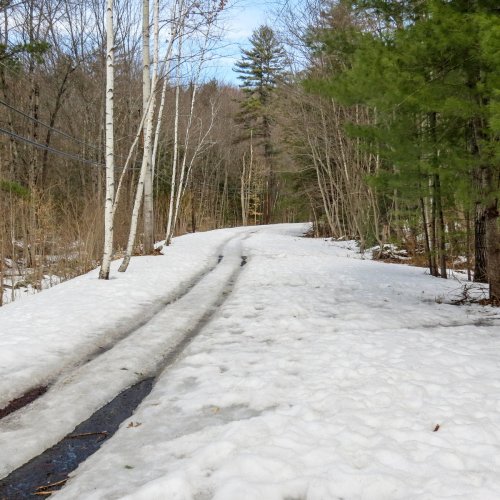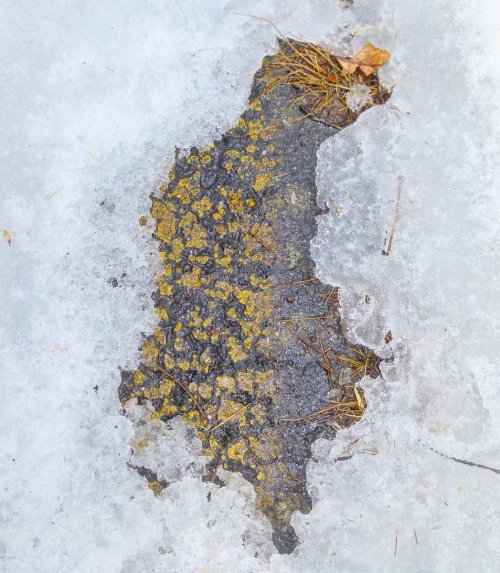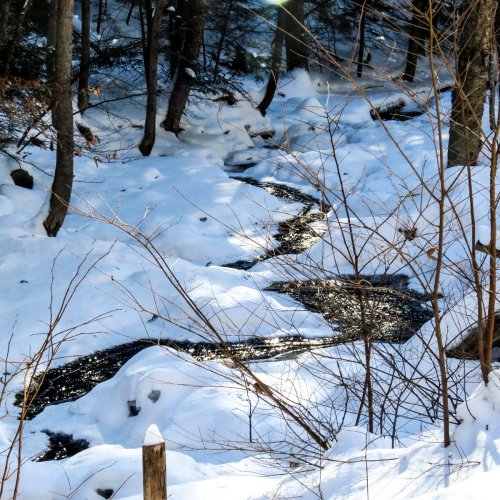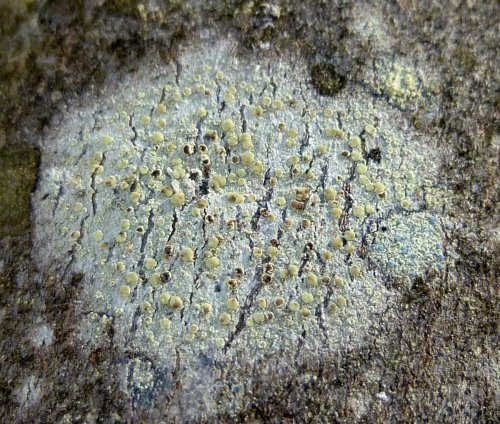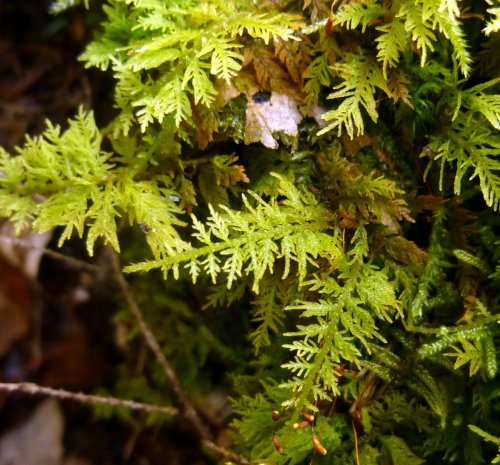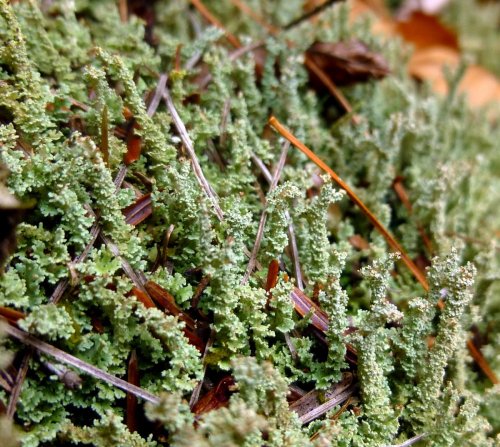I agreed, back in February, to help a group of Pathfinders get some merit badges by helping them find mosses, lichens, and liverworts. Pathfinders range in age from 10 to 15 I think, and are kind of like scouts, at least when it comes to earning merit badges. Of course as soon as the plans were finalized it began to snow and it didn’t stop until nearly every living thing was buried under feet of it. We’ve had some warmth since though, so recently I decided to check out the old abandoned road near Beaver Brook in Keene to see if we could get in there without snow shoes.
The snow had melted well on the hillsides along the sunny side of the road but the road itself still has as much as 6 inches of loose granular snow in places. Tough to walk in, but not impossible. Good, waterproof hiking boots will be best for this trip.
The hillsides along the shady side of the brook still had quite a bit of snow on them.
The last time I was here the wind had blown so much snow against the ledge faces, you wouldn’t have known they were there if you weren’t familiar with the place. Many of the mosses, lichens and liverworts that the Pathfinders want to find grow on these ledges so it would have been a waste of time.
Dog lichen (Peltigera membranacea) is just one of many things that grow here that I rarely see anywhere else. Dog lichens aren’t fussy and will grow on soil, stone or bark but they do seem to like moist, sunny spots. They also always seem to grow near moss, probably because moss soaks up water like a sponge.
Chances are the Pathfinders won’t realize how special what they’re seeing actually is, but I plan to tell them that this is the only place that I’ve ever seen this stair step moss (Hylocomium splendens.) It is also called glittering wood moss and grows on the side of a large boulder here. It could be that I rarely see it because it usually grows in the boreal forests of Canada, Europe and Russia. I’m not sure why this particular example is growing so far south. This moss was once used to plug gaps between the logs in log cabins. It has anti-bacterial qualities.
Rose moss (Rhodobryum roseum) is one of the most beautiful mosses in my opinion and like the stair step moss, this is the only place I’ve ever seen it. This moss gets its common name from the way the small rosettes of leaves resembled rose blossoms to the person who named it. The example that grows here is large and I think must be quite old. It grows on the flat top of a boulder. As the photo shows, the rosettes grow so dense that you can’t even see the stone.
Yellow feather moss (Homalothecium lutescens) is another moss that’s rare in this area, at least in my experience. This small clump is the only one I know of. It’s looking a little bedraggled because of being covered by snow all winter, but at least the Pathfinders will be able to see it.
I don’t know too much about geology but I do know that there are some interesting things to see here among the ledges, including garnets, milky quartz crystals, and veins of feldspar. I also know that I could build a nice looking wall with the stones in this section.
In places the ice that covered the brook all winter has completely melted and the silence of winter has been replaced by the chuckles and giggles of spring water moving over and around the stones. Be more like the brook, I remind myself. Laugh your way through life and just flow around any obstacles that might appear.
Not all of the brook is ice free. There were still some impressive icicles to be seen.
The lower section of Beaver Brook Falls had shaken off its think coating of ice and was announcing spring with a roar. It’s amazing to come here in the dead of winter when even they are silent. Ice makes a very good sound insulation.
Greater whipwort (Bazzania trilobata) will fulfil the Pathfinder’s one liverwort requirement. Their need for 5 each of lichens and mosses will easily be met here as well. This liverwort doesn’t grow everywhere but it isn’t really rare either. I always find it growing on stones near a brook or a stream. At a glance it might fool you into thinking it was a moss but a closer look reveals the three tiny lobes at the base of each leaf that give it the trilobata part of its scientific name. This liverwort is the host plant for the larva of a moth known as the gold cap moss eater (Epimartyria auricrinella.)
A while ago I did a post about all of things that I found growing on a single tree, and in it I mentioned how I had been seeing a lot of long white fibers hung up on lichens especially. Well, now they’re getting hung up on moss too, and they’re blue. I found this little bundle on some dry tree skirt moss (Anomodon attenuates.) I wonder if a bird was collecting it for its nest and dropped it. I don’t see many humans where this particular moss grows.
The snow had melted enough in one spot to see a little piece of the yellow line that still runs up the middle of this old road. Since the temperature reached into the 60s F yesterday I’m hoping to see a lot more of it next week when the Pathfinders are here.
If a child is to keep his inborn sense of wonder, he needs the companionship of at least one adult who can share it, rediscovering with him the joy, excitement, and mystery of the world we live in. ~Rachel Carson
Thanks for stopping in.
